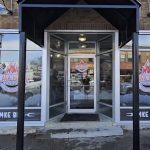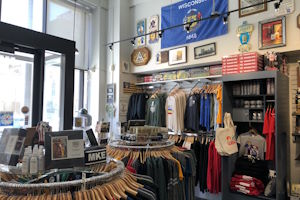2006-01 Vital Source Mag – January 2006
This moment
By Lucky Tomaszek When our babies are small, and so incredibly needy, it’s easy to say, “When she’s bigger, it’ll be easier.” And as our children get older, more independent and likely much mouthier, it’s easy to say, “I wish you were still small enough to fit into the crook of my arm. It was easier then.” The truth is that for some things, it’s easier to have a tiny baby who can’t get into any trouble. For other things, it’s easier to have an older child who can help you remember your grocery list and play outside in the afternoon. There are wonderful moments with children of all ages. The key is to find those moments and live in them. Not looking forwardThis past autumn, my son Jeffrey suffered an eye injury. The kids were playing school in the bedroom and using the fold-up music stand as a desk. It fell and poked him right in the eye. I heard him scream from my bedroom and went running. The girls were already surrounding him, trying to get a peek at the damage. “He hurt his eye, Mama.”When I bent down to look, I expected a bump, a bruise, maybe some swelling. What I saw was blood tears running down his sweet five-year-old face. I had a moment of panic as I realized that the injury was worse than I had envisioned. He couldn’t open the injured eye and was in a lot of pain. Immediately, I flashed on the image of him permanently blind and perhaps patched for the rest of his life. I could hear the stories from future Thanksgiving dinners, “Yeah, Uncle Jeff had perfect vision until he was five…” Pushing these thoughts out of my head, I picked him up and headed out to the ER. A thorough exam showed that he had sustained two injuries, one inside his eyelid and the other across his cornea, costing him about 95�f his vision in that eye. The doctors said it would get better. Eyes heal very quickly and they were pretty confident that his vision would restore itself as the wound closed. We dosed him up with ibuprophen and brought him home.As he lay across my lap on the sofa, finally sleeping after his ordeal, I was grateful for the peace around us. His breathing slowed to match mine and his sweet, sweaty little body was pushed in close to me. Relieved by the news from the doctor, I remembered my earlier worry that he would be permanently blind after the accident. If it had happened, we would have all adjusted. Jeffrey is a good-natured kid, and he would have come through it just fine. But our lives would have changed in a very real way. Remembering my promiseIn that moment, I renewed the vow I made to myself years ago. I was going to try harder to recognize the importance of every day I spend with my kids. This is so important to me, as a […]
Jan 1st, 2006 by Lucky TomaszekOf guns, gays and gas.
By Lefty McTighe In case you haven’t been paying attention, fellow Wisconsinites, your GOP-controlled State Legislature has been hard at work for you this past December, tackling the pivotal issues that truly matter most. In a political trifecta that pushes all sorts of emotional buttons, the Republican leadership in both the Senate and the Assembly will have closed out the 2005 calendar year with votes to allow citizens to carry concealed handguns, place a constitutional ban of gay marriage on the November 2006 ballot and end the automatic increase of the state gasoline tax. If you thought health care, education and job creation were important, well, you are clearly out of step with your lawmakers. You simply don’t share the values and priorities of those you have sent to Madison. Each of these GOP-sponsored initiatives tug at the heartstrings of the conservative base, mixing Republican catchphrases like ‘tax cuts,’ ‘gun rights,’ and ‘family values’ into one delectable brew served up to the narrow interests of the rabidly right wing. For the rest of us hoping to find a better job, a better school for our kids, or maybe even expanded health care coverage for our family, we will have to wait our turn until the important business of the state gets done first. But that’s not even the most troubling part of the story. For those of us rightfully outraged by the backward priorities of the Republican legislature, there is another group of folks who should be even more irate: those conservatives who genuinely care about concealed handguns, gay marriage and the gas tax. Because in truth, these bills fail to adequately solve the problems they claim to fix. These proposals have been shepherded through the Legislature by political flim-flam artists in the Republican leadership who have put their personal electoral success above sound public policy. Not only are they abdicating their responsibility to address real issues that matter to most voters – like health care, education and jobs – they have gleefully played on the worst fears of their conservative base, playing them for suckers and hoping to whip them into a panicked frenzy and send them flocking to the polls. Who benefits from this ploy? The GOP members of the Legislature and the Republican Party of Wisconsin in this November’s elections. GUNSThe new legislature-approved bill would allow those 21-years and older to carry a concealed gun once they pass a state sanctioned training program. For those who worried that there were not enough guns on the street, hand-wring no more – now it’s legal to walk around the neighborhood strapped. Of course, there are limits. Lots of them. According to the December 7 edition of the Milwaukee Journal Sentinel, these are the places where concealed guns would be prohibited: child care centers, domestic violence shelters, churches, hospitals and clinics, schools, college campuse, police stations, prisons, jails, courthouses, most sporting events, airports, taverns and restaurants where alcohol accounts for more than half of sales. Additionally, public facilities and private […]
Jan 1st, 2006 by Vital ArchivesCasablanca
By Catherine McGarry Miller + photos by Kevin C. Groen Christmas carols aside, Jerusalem is not currently known for its harmony. But for Jesse Musa, chef and owner of Casablanca, it was a place that lived up to its Hebraic name: �yerusha shalem,� or heritage of peace. Musa recalls his hometown as a pleasant, beautiful city where he and his family enjoyed a comfortable lifestyle. �My family was Muslim. We went to public school with Christians and Muslims together. There was no difficulty,� he recalls, �because everyone grew up together in the same neighborhood. We didn�t see any difference between Muslims and Christians. We all believed in God. I didn�t see the differences until I came here [to the United States].� Musa avoids the conflict by viewing the news like a dieter looks at dessert: a monthly indulgence at best. Musa�s father and grandfather owned a restaurant and pastry shop. From the age of 10, Musa helped his father after school. �It [cooking] was something secure that I could make a living on and I love it. I�m happy with my job � it�s lots of hours but I enjoy it.� In 1971, at the age of 20, Musa came to the United States with his father and worked for several years at the Syrian Bakery in Chicago before moving to Milwaukee where several of his older brothers had already settled. Musa ran a couple of neighborhood groceries before opening the Sahara Inn on Mitchell Street in 1987, which he later renamed Casablanca. Musa built his menu on the rich tradition of Middle Eastern recipes perfected by his father and grandfather. Lunchtimes, Musa served a large vegetarian buffet with lentil soup, falafel, a dozen salads, five or six hot entrees and baklava for dessert. I generally don�t recommend buffets, which too often rely on mass quantities of mediocre food, but Musa�s cornucopia of fresh and flavorful delights has always been an exception for me. Throughout his years in business, Musa maintained consistently high quality food at reasonable prices. His lamb and chicken dishes are excellent. Once a friend of mine and I each enjoyed his Lamb Kifta Kabob so much, we ordered a third one to share. �I am very patient with food,� Musa muses. �I give it the time it needs to be cooked, I don�t rush my food. Maybe it takes more time, but it has to be right.� And it is. In 1993, Musa moved to Oakland Avenue in Shorewood, but by 1996, he was back in his original location on Mitchell Street. His customers happily followed his peripatetic business. Three years ago, Musa retired and closed his much-loved restaurant. That might have been the happy ending to a success story if it were not for his children. Musa�s son Alla said, �I tried Middle Eastern [food] everywhere while father was closed but found nothing like my father�s cooking. Maybe I�m prejudiced, but � we grew up in the restaurant business. Dad had a great reputation and […]
Jan 1st, 2006 by Cate MillerRevealing light
By Evan Solochek Bruce Nauman has spent his life and career bending artistic conventions, one of the few living artists successful at avoiding labels. And regardless of how one feels about the work itself, he is inarguably viewed as one of the most innovative living artists of our time. Recently, Nauman made the top 10 of the London Financial Times� �Top 100 Art World Movers and Shakers.� Born in Fort Wayne, Indiana in 1941, Bruce Nauman�s family followed his father�s job as an engineer for General Electric around the country. They landed in Milwaukee while Nauman was still a boy. He attended the University of Wisconsin-Madison, where he began honing his renaissance approach to life and art, studying mathematics and philosophy, music and physics. Eventually, Nauman�s interests began to focus on what would bring him fame in later life, and in 1964 he graduated with a Bachelor�s Degree in Art. The following year, Nauman began work on his Master�s Degree at the University of California-Davis, where success found him quickly. In 1965, at the age of 24, he headlined his own gallery show and published his first art book, Pictures of Sculpture in a Room. Nauman originally studied painting, but felt limited in the medium�s ability to adequately subvert what he saw as artistic preconceptions and order, and quickly abandoned it. Entranced by the old neon beer signs he saw from the window of his first studio in San Francisco (a former grocery store), Nauman turned his attention to the light itself, using its stark but fluid form and motion to play with language, imagery and iconic symbols. And while he has successfully explored a wide variety of mediums from sculpture to video, it is his work with neon that has garnered the most widespread attention. With works like My Name As Though It Were Written on the Surface of the Moon (1968), in which he tackles the relationship between name and identity, and One Hundred Live and Die (1984), which bombards the viewer with the banalities of life and forces reevaluation, Nauman sits at the top of the art world. And while each piece has its own identity and message, an overreaching theme does exist. �Nauman makes artwork that doesn�t look like art,� says Joseph Ketner II, Chief Curator of the Milwaukee Art Museum. �He wants to make it in a non-traditional medium, and so he employs a commercial medium, neon signs.� While rebellion and non-traditional art is nothing new, one facet of Nauman�s work transcends conventional subversion. He doesn�t �make� any of it. Nauman designs his pieces on paper, then hands the plans over to a neon fabricator to construct. �It parodies this whole romantic notion of the artist hand being the supreme expression of humanity,� Ketner says. �This whole exhibit will contain no objects touched by Bruce Nauman.� This inevitably raises questions about basic artistic tenets. Can a man who never physically touches his own art be considered an artist? What�s more important, the vision or the […]
Jan 1st, 2006 by Vital ArchivesForgotten Milwaukee
By Frizell Bailey In the December 2005 issue of Vital Source, the “Forgotten Milwaukee” series began to examine school choice. School choice has been controversial politically, with white Democrats largely opposing the policy and Republicans among the staunchest supporters. This does not hold true among black Democrats. Black parents overwhelmingly support school vouchers. According to the Pew Research Center for the People and the Press, 60 percent of African Americans support school vouchers and only 35 percent oppose them. This is almost the same margin of support as Republicans hold for the voucher program. But that “choice” is somewhat limited. The Wisconsin program only allows 15 percent of public school students in MPS to choose a charter or voucher school. There’s also the problem of transportation. More than half of choice schools offer either limited or no transport for students, and the program itself doesn’t provide any transportation guidelines or requirements. Income affects outcomesI do not question the conventional wisdom that public schools have failed students. However, a simple fact often gets lost in the debate over not leaving children behind: teaching is really hard. And teaching at-risk students is even harder. I found this out firsthand as a middle and high school teacher in the Mississippi Delta. Like many new, young teachers I thought I’d march in like Sidney Poitier in To Sir, With Love. Instead, I found the job to be far more difficult than I had imagined. Here’s the problem. What I didn’t understand at the time was that when poverty is extreme, people loose hope. It’s difficult to see the value of education when the only people around you that have educations are teachers or people who don’t look like you. I spoke with two local educators to explore this idea within Milwaukee Public Schools. Dr. Aquine Jackson is the chief academic officer for the district. Kathy Williams leads the Division of Teaching and Learning for MPS. Both agree that income plays a role in the success or failure of students. The key issue, according to both, is one of preparedness. Students whose parents don’t have the time and resources to provide educational experiences to complement what happens in the classroom are at a disadvantage. This doesn’t change the reality that schools have a responsibility to educate such students, but it does make it more difficult to close the achievement gap. It is widely believed that a socially, economically and ethnically diverse student body benefits students, especially poor students. Just as is true for concentrations of poverty in housing, having a student body that is comprised primarily of students from disadvantaged backgrounds adversely affects their academic success. “There has been research that supports the idea that when there is economic diversity in schools, students make more rapid gains than when they are all in the lower income bracket,” William says. “There is not as great a concentration of needs and students learn from each other.” Williams believes that the problem is one of overtaxing the system. […]
Jan 1st, 2006 by Frizell BaileyBabyshambles
By Paul Snyder Stateside knowledge of Pete Doherty is little more than �that walking hypodermic needle that got Kate Moss hooked on cocaine.� In England, he�s revered as a romantic, tragic figure: always arrested for possession, always missing gigs, always getting his ass kicked, and always writing great songs along the way. He was part of The Libertines, though his own demons got him ousted before they�d made their U.S. debut. But while the other three limped to their finish, Doherty formed Babyshambles and released a couple of punchy singles intent on outdoing his old mates and re-instilling faith in his pale, skeletal frame. Down in Albion was intended to be the pièce de résistance. It�s a piece, all right � 16 scatterbrain tracks that scream �addict!� far more often than �genius!� The lyrics so frequently recycle the themes of fading belief, depression and pleas to be left alone that they caricaturize themselves before the record�s finished. �I can�t tell between death and glory.� Er� right. Clever. The thing is, with some proper guidance and editing, this could have been a sucker punch. It�s hard to deny the great spark in �The 32nd of December� and �Loyalty Song,� but they�re in such droll company that no fire is ever allowed to catch. So download those two, plus the single of �Killamangiro� and their sprightly contribution to the Help! benefit album, �From Bollywood to Battersea.� But don�t shell out for this mess; if you do, you already know how Pete�s going to spend the money. VS
Jan 1st, 2006 by Vital ArchivesCat Power
By Erin Wolf Cat Power�s Chan Marshall has become something of a gothic folk legend, like the music she�s created over the past decade. Part indie rocker, part folk storyteller, part mystery, with complements of dark and brooding lyrics and extreme stage fright and self-doubt, Marshall rises above all her clouds with The Greatest. Going back to her Georgian roots, she employs her cultural background as the main emphasis on The Greatest, leaving the foundation of previous albums. Sonically, she re-constructs and tweaks her new songs with the help of capable Memphis musicians, including Al Green�s guitarist Mabon �Teenie� Hodges, Jim Spakes on saxophone and Doug Easley for a little dose of pedal steel. The Greatest begins with the startlingly beautiful title track about a boy who wants to be a boxer; its wistful reflection sets the tone for the album. The second track, �Living Proof,� warmly swells with horns and organs, showcasing Marshall�s lovely, throaty voice, which is better suited to the role of soul singer than dejected chanteuse. The Greatest features personal songs soaked with the languidness of a Southern afternoon, favoring relaxed storytelling and at times breaking the circle with piano-crooning introspection. 2006 finds Cat Power in a more comfortable and truly natural place � it�s as though all the tension and angst from previous albums has finally run its race, and Marshall is finally at ease. The Greatest speaks volumes for her personal journey. VS
Jan 1st, 2006 by Vital Archives




















